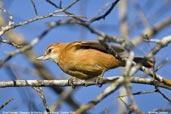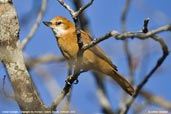Brazilian name: Bico-virado-da-caatinga

October 2008
The Great Xenops is a Brazilian endemic. It was previously classified as Near Threatened but is now regarded as being less under threat given its apparent tolerance to degradation of its habitat. It is only found in the caatinga woodland of north-east Brazil.

It probably got its name as a result of its sharply upturned lower mandible which is pale at the base. It is a magnificent shade of cinnamon-rufous with a contrasting white throat and a bit of grey around the eyes.

There are recordings on xeno-canto, a distribution map on NatureServe and additional information available via Avibase.
| Previous Page | Back to Index | Next Page |